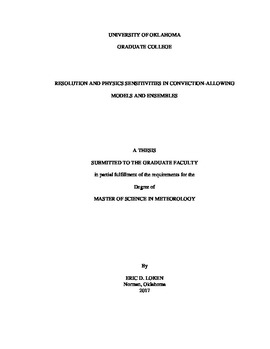| dc.contributor.advisor | Clark, Adam | |
| dc.contributor.author | Loken, Eric | |
| dc.date.accessioned | 2017-07-27T15:50:20Z | |
| dc.date.available | 2017-07-27T15:50:20Z | |
| dc.date.issued | 2017-08 | |
| dc.identifier.uri | https://hdl.handle.net/11244/51843 | |
| dc.description.abstract | In recent years, convection-allowing models (CAMs) and ensembles have become more prominent in both research and operational settings. However, it largely remains unclear how to leverage computing resources to maximize forecast quality and value at convection-allowing resolution. In this thesis, two research components are designed to address questions regarding convection-allowing ensemble design and the optimal use of computing resources.
The first component uses data from the 2010 and 2011 NOAA Hazardous Weather Testbed Spring Forecasting Experiments (HWT SFEs) to compare next-day probabilistic severe weather forecasts derived from simulated updraft helicity (UH) from three Advanced Research Weather Research and Forecasting (ARW-WRF) model configurations: a 4-km deterministic CAM; an equivalently-configured 1-km deterministic CAM; and an 11-member, 4-km convection-allowing ensemble. Results from this component suggest that creating a convection-allowing ensemble at relatively coarse grid-spacing may be a better use of computing resources than reducing the grid-spacing of a deterministic CAM.
The second research component uses data from the 2016 Community Leveraged Unified Ensemble (CLUE), which was assembled during the 2016 HWT SFE, to compare the spread and skill of mixed- and single-physics convection-allowing ensemble forecasts of 2-m temperature, 2-m dewpoint temperature, 500-mb geopotential height, and hourly accumulated precipitation at a variety of spatial scales. Up to 36-hour forecasts are analyzed. Results from this component indicate that, although the mixed-physics ensemble tends to produce forecasts with greater spread and slightly greater skill, the differences between the two ensemble forecasts are generally small, especially at larger spatial scales and when the ensembles are well-calibrated. Model developers may therefore wish to consider implementing a single- rather than a mixed-physics ensemble operationally, given the similar performance but smaller maintenance costs of the single-physics ensemble. | en_US |
| dc.language | en_US | en_US |
| dc.subject | Convection-allowing models | en_US |
| dc.subject | Convection-allowing ensembles | en_US |
| dc.subject | ensemble spread | en_US |
| dc.subject | updraft helicity | en_US |
| dc.subject | horizontal resolution | en_US |
| dc.subject | mixed physics | en_US |
| dc.subject | ensemble | en_US |
| dc.title | Resolution and Physics Sensitivities in Convection-Allowing Models and Ensembles | en_US |
| dc.contributor.committeeMember | Brooks, Harold | |
| dc.contributor.committeeMember | Xue, Ming | |
| dc.contributor.committeeMember | Furtado, Jason | |
| dc.date.manuscript | 2017-07-27 | |
| dc.thesis.degree | Master of Science in Meteorology | en_US |
| ou.group | College of Atmospheric & Geographic Sciences::School of Meteorology | en_US |
